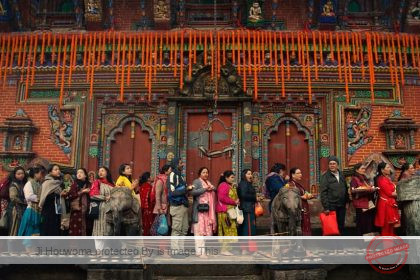Communities of all faiths, whether Hindu, Buddhist, Muslim, or any other, come together to celebrate Tihar as a social festival in perfect harmony. Tihar is a festival of lights and colors that is celebrated by all Nepalese communities.
Dashain, Tihar is Nepal’s most important holiday, with its rich and unique culture and traditions. The five days of Tihar are loved to the fullest because each day has its own importance. Adults and children from a neighborhood get together to play Deusi-Bhailo and go door to door in the same or another neighborhood, promoting social interaction. In the house, relatives or neighbors come together to prepare sweet foods, Selroti, and the Tihar feast. They socialize with each other in this way. They get to know one other better while having a good time. During the Tihar celebration, it is customary to join together to play swings in a public space.
Tihar is also a festival dedicated to the reunion of siblings. Brotherhood and Sisterhood are treasured and cherished. Along with having fun and entertainment, the spirituality of the custom is safeguarded and nurtured for generations to come. The joy of gathering about, hearing to grandmother and grandfather’s lengthy back stories, and meeting those siblings who had been away for the time being is overpowering.
There are several preparations to be made for Tihar, and as a result, family members and relatives converge to help. Tihar is also a time when neighbors join together to celebrate. The house comes alive with laughter and talk in the kitchen and living room as several feasts are prepared. The fireworks are enjoyed by the children with their families or siblings.
Why is Tihar in Nepal known as the Festival of Lights?
In Nepal, Tihar is referred to as the “Festival of Lights” for a number of important reasons, the most notable of which being the burning of oil lamps, or “dip” or “diyo.” The lamps represent the triumph of good over evil and light over darkness, which is a major theme in the festival’s spiritual meaning. Dipawali is referred to as the Festival of Lights for the following reasons:
- Worship of Goddess Laxmi: To honor the Hindu goddess of wealth and success, Laxmi, homes are lavishly adorned with oil lamps and electric lights on Laxmi Puja, the third and most significant day of Tihar. Laxmi is said to visit hygienic, well-lit homes to bestow wealth and good fortune on its occupants.
- Mandala and Light Decorations: To add to the joyful atmosphere, people adorn their houses and courtyards with vibrant rangolis, which are designs created with colored powders or flowers, and surround them with lamps. The lights attract good vibes and accentuate the beauty of the elaborate decorations.
- Symbol of Happiness and Protection: Lighting lamps is a religious practice that also serves as a symbol of defense against evil energy. Families may enjoy a safe and joyful celebration since bright lights are thought to ward off evil spirits.
- Celebration and harmony: Tihar unites communities in celebration, and the communal lamp-lighting in neighborhoods promotes happiness and harmony. Beyond individual homes, the festival’s lights produce a lively, communal ambiance of coziness and joy.
- End of Harvest Season: Lighting lamps is a celebration of nature’s plenty and the harvested abundance since Tihar falls at the end of the harvest season. Families use this time to express gratitude and thanks, and the lights represent hope for a successful new year.
Tihar is appropriately referred to as the Festival of Lights in Nepal because of the profound spiritual, cultural, and social significance of the beautiful, shining lamps that are lit during this time.
What distinguishes Tihar from Diwali?
Although there are many similarities between Tihar and Diwali, such as the burning of lamps and the celebration of prosperity, Tihar places greater emphasis on sibling bonds and animal worship. In India, Tihar also lasts for five days, although Diwali is usually celebrated for just one day.
What are the main Tihar customs?
Important Tihar customs include
- Diyo, or oil lamp lighting, is a way to welcome wealth.
- Worshiping oxen, cows, crows, dogs, and other creatures.
- Adorning siblings with garlands and tika during Bhai Tika.
- Giving gifts and singing Deusi and Bhailo songs.
- Creating rangoli patterns at doorways to draw in good vibes.
Which meals are typically consumed during Tihar?
Typical dishes made during Tihar include:
- Sel roti is a rice doughnut in the shape of a ring.
- Barfi is a dessert that is sweet.
- Laddu are circular, sugar-and-flour-based sweet balls.
- Family and neighbors share meat dishes as well as a range of seasonal appetizers and sweets.
Does just Nepal celebrate Tihar?
Although Tihar is celebrated most notably in Nepal, it is also commemorated in several regions of India, especially in places where there is a significant Hindu or Nepali community. It is frequently called Deepawali or Diwali in India.







